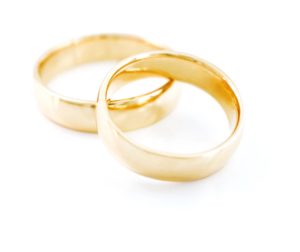 Platinum
Platinum
Platinum is the strongest precious metal used in jewelry. Its high melting point ensures good resistance to corrosion and chemical attacks. Each time other metals are scratched or polished, a tiny bit of the metal is lost. Though a scratch in platinum may leave a mark, the metal is so strong that it will not readily chip or splinter.
Some appealing characteristics of platinum are its subtle beauty and its tendency not to add color of its own. This helps enhance the natural brilliance and fire of a diamond because the light entering the diamond does not take on the color of the platinum. This makes platinum a popular choice for diamond jewelry settings.
To make sure that the jewelry you are purchasing is indeed platinum, check the amount of platinum content on the back of the piece. Look for the marks of "950Pt", "950 Plat", PT, or "Plat", to ensure that the jewelry does indeed contain platinum. Older platinum pieces may be stamped 90/10 which uses a different alloy and process. Platinum jewelry is 95% pure platinum.
Platinum is heavier than gold and more pure. It is more expensive and doesn't require plating.
When cleaning your platinum a warm solution of water and mild soap can be used. Soak the piece in the solution and gently scrub it with a soft-bristle brush. By doing this you will be able to maintain the metal's luster.
Gold
Due to its physical characteristics, gold is extremely well suited for use in jewelry making. Gold will not tarnish, rust, or corrode, and even though it is very strong, it is the most malleable of all metals.
Gold in its purest form (24k) is too soft to be used in functional jewelry. Abrasions caused by daily wear would begin to degrade a piece of jewelry made from 24k gold. Therefore it is alloyed with other metals to give it strength. The percentage of alloys that are added to the metal determine the color of gold. When alloyed with silver, copper, and zinc, the shade of yellow will vary. When alloyed with nickel, copper, and zinc, it becomes white gold. Yellow and white gold share the same strength and malleability characteristics. Rose gold has more copper alloy.
The purity of gold is measured in karats. 24k is 100% pure gold and is far too soft for jewelry. 18k is 75% pure gold, and 14k is 58.5% pure gold; both are recommended for fine jewelry. We do not recommend 10K gold.
Gold's value depends on its purity and weight. Also taken into consideration is the design and the construction of the piece of jewelry.
To care for your gold jewelry, avoid exposing it to chlorine and other harsh cleansing agents. To clean your gold jewelry, wash it in a warm solution of water and a non-detergent soap. Scrub gently with a soft-bristle brush. Finally, store your gold jewelry in its own soft cloth pouch or individual compartment in a jewelry case to avoid scratching. Following these recommendations will help to maintain the luster of your gold jewelry.
Silver
In its purest form, silver is soft and very malleable. Pure silver is very susceptible to damage, so it is usually combined with other metals (most often copper) to produce a more durable alloy. The most popular of silver alloys is sterling silver, which consists of 92.5% silver and 7.5% copper. Marks that indicate the quality of silver include: "sterling", "sterling silver", "ster", and ".925".
The value of silver is based less on its purity and more on the skill and creativity of the artist, as well as the intricacy of the design.
To care for your silver jewelry, avoid exposing it to chlorine and other harsh cleansing agents. Store your silver jewelry in its own soft cloth pouch or individual compartment in a jewelry case to avoid tarnish and scratches. Following these recommendations will help to maintain the beauty of your silver jewelry.
To clean your silver, use polishes formulated specifically to remove tarnish. These tarnish removers can be found at hardware stores and craft stores. Remember, tarnish is most easily removed when it first becomes visible.

